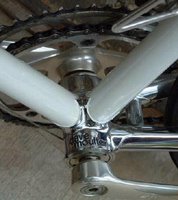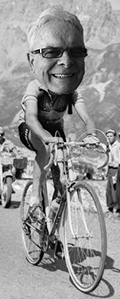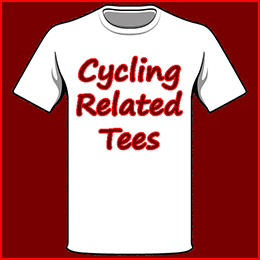Perfectionism
 Sun, December 4, 2005
Sun, December 4, 2005 
Sometimes a person will say to me, “I am a perfectionist.” They say it with pride as if perfectionism is a virtue. Perfectionism is a curse that will bring nothing but misery to the perfectionist and those around them. It is a personality trait that goes hand in hand with low self esteem. Why? Because you can never achieve perfection, you are always a loser.
My own perfectionism led to my success as a frame builder but self hatred and anger as a person. My perfectionism was caused by abuse not only from my father but by the British school system; a system that beat down kids, and used sarcasm and ridicule as well as physical abuse. If you have seen the Pink Floyd movie “The Wall” you will know what I mean. That movie touched me deeply and helped me understand later what was going on.
I believe the reason all the great music came out of Britain in the 1960s was because of our childhood during WWII and the school system there. I was just another child of that era whose creativity went in a different direction. But for the fact my anger was directed towards myself I could have just as easily gone a different direction. Had my anger been directed towards others I could have become a violent criminal as many of my generation did. This forms the basis for my novel Prodigal Child It is a work of fiction, a story of what my life might have been had it taken a different turn early on.
As a child I was never given credit for doing well; only punished for doing wrong. As an adult I continued with the self punishment if I screwed up and I would not tolerate anything but perfection from myself. This led to success as an artist, but failure in every other aspect of my life. Many times in my early days as a framebuilder I would take a hammer and destroy a frame because of some minor flaw. Afterwards I would sit and cry like a child, then work all night to replace the frame. This was my punishment for screwing up.
By the late 1980s my second marriage failed and I realized I needed to change. I was not always a pleasant person to be around; the sheet rock on the walls of my frame shop was full of the impressions of tools I had thrown across the room in a temper tantrums. The anger was always directed at myself never others, but those around me had to witness and listen to this. I knew I had to change; for my own sake as well as others around me. I started to look deep within myself to see why I was the way I was.
By the early 1990s the bike business had also changed. Bicycle dealers almost overnight it seemed were switching from road bikes to mountain bikes. By 1993 I knew it was time to leave and there was one incident that I think pushed me over the edge. A customer called me saying his Fuso Lux frame he had bought had a tiny bubble in the Columbus decal. Columbus decals were always a pain because of the material they were made from caused them to bubble when the paint was being baked in the paint oven. This is why you don’t see a Columbus decal on a custom ‘dave moulton’ frame.
I told the customer to send the frame back. When it arrived the “bubble” in the Columbus decal was buried deep within the clear coats and was so tiny you almost needed a magnifying glass to see it. I stood there looking at it, seething with anger. I had finally come to terms with my own perfectionism, but still had to deal with the perfectionism of others. This customer expected me to repaint this frame and there was no guarantee if I did that the Columbus decal would be any different, and maybe it would be even worse.
The frame was in a vise held across the bottom bracket faces. If a fit of rage I grabbed the head tube and folded the frame in two with the head tube ending up next to the rear drop-outs. This time I did not cry; I did not stay up a night building a replacement. Instead I walked into my office and wrote the customer a check for the full retail value of the frame. I attached the check to the frame with scotch tape, threw it in the box and shipped it back. I never heard from him again.
As well as coming to terms with my perfectionism I realized that all creativity comes from the same source. It is not a right brain, left brain thing; it comes from deep within the artist, his soul or very being. The artist is simply a vehicle through which art appears. Because all art comes from the same source; all art is the same and if I had been successful in one art form, I could do so in another.This is why I was able to leave the bike business and take up writing and songwriting. If I screw up in writing unlike frame building it’s easily fixed in a rewrite.
Writing has been great therapy for me; better to get all this shit out than to hold it inside. Which is exactly what I am doing now so thank you for allowing me to indulge myself?
 Dave Moulton | Comments Off |
Dave Moulton | Comments Off | 




















